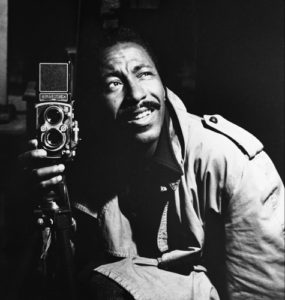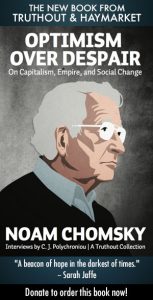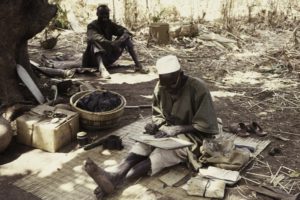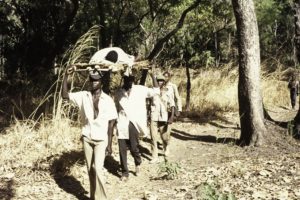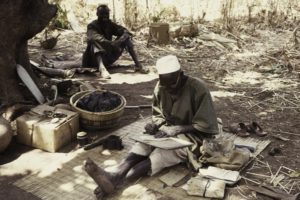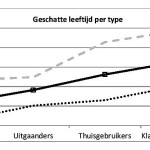Martha Gellhorn ~ A Furious Footnote In History
In a man’s world she was one of the few women. Whereas her fellow journalists reported the war as if keeping score, she concentrated on the reality behind the statistics. She reported the Spanish Civil War, the Second World War, Vietnam and Panama. What is it that drives her to these hotbeds ? An interview (conducted in 1991) with an angry old lady.
In 1983, and far into her seventies, Martha Gellhorn can contain her anger no longer. This time the destinations are Nicaragua and El Salvador. She still shudder at the memory.
‘In Central-America was the first time I’ve ever felt real fear. You couldn’t see or hear the danger approaching. Suddenly it was there.’ Back at home England’s Granta publishes a report of hers on an instance of torture. Described in minute detail from the victim’s own account, smuggled out to her under the greatest secrecy – via the Red Cross – by a representative of a human rights organization in San Salvador.
‘There are murders committed every day in El Salvador and it’s costing the American taxpayer enormous sums of money, for no reason. We support these murderers. This has to be stopped.’
Her war coverage, collected in the book The Face of War, and her own choice of her peacetime writings The View from the Ground, are the distillations of sixty years of anger and indignation at the state of affairs in the world in general and in her native United States in particular.
‘The reason I’ve been able to travel all over the world and talk to anybody I want, is that I appear to be harmless, unimportant. I don’t make notes, it’s just like talking to a stranger in the street. If you have a photographer with you or take notes, people notice straight away. They become aware of the situation and tense up, they become cautious, less natural. And, in any case, I wasn’t important enough to have a photographer along.’
In the television film Hemingway Martha Gellhorn is presented as a fanatical, blonde and ambitious journalist. Fanatical she has never been, blonde she has and if it’s ambitious to want to be heard, than she is ambitious. Before she met Hemingway, on holiday in Florida, she had already written a book about unemployment in America in the thirties, entitled The Trouble I’ve Seen. Later she published short stories, ten novels and account of the travels: Travels with Myself and Another.
She married Hemingway in 1940, but the marriage wasn’t to survive the Second World War.
‘I was married to that terrible man for four of five years and am punished daily for that. I don’t want to see his name in your article’, she decrees with a determined look in her eyes. At eighty-one Gellhorn still shows traces of being the beauty to whom Hemingway dedicated For Whom the Bell Tolls.
In the Spring of last year (1990) Bill Buford, Editor-in-Chief of Granta receives a telephone call from Martha Gellhorn. This time it’s Panama. Her report is rife with distrust of the official American version of events. Distrust also of the American and Panamanian authorities. Five thousand words, one for each of the estimated number of dead. The number of injured is unknown. ‘They remain unseen. The Panamanian authorities have admitted that in one night fifteen thousand families were made homeless.’ Read more
The Gordon Parks Foundation
Gordon Parks was one of the seminal figures of twentieth century photography. A humanitarian with a deep commitment to social justice, he left behind a body of work that documents many of the most important aspects of American culture from the early 1940s up until his death in 2006, with a focus on race relations, poverty, civil rights, and urban life. In addition, Parks was also a celebrated composer, author, and filmmaker who interacted with many of the most prominent people of his era – from politicians and artists to celebrities and athletes.
Born into poverty and segregation in Kansas in 1912, Parks was drawn to photography as a young man when he saw images of migrant workers published in a magazine. After buying a camera at a pawnshop, he taught himself how to use it and despite his lack of professional training, he found employment with the Farm Security Administration (FSA), which was then chronicling the nation’s social conditions. Parks quickly developed a style that would make him one of the most celebrated photographers of his age, allowing him to break the color line in professional photography while creating remarkably expressive images that consistently explored the social and economic impact of racism.
Go to: http://www.gordonparksfoundation.org/artist
Great Lakes Of Africa ~ From Problems To Solutions
 “People are the problem, People are the solution” the keynote speaker’s concluding words at the first Great Lakes of Africa Conference held in Uganda in May 2017, generated a flurry of nods and agreements. Entebbe hosted over three hundred delegates at the shores of Lake Victoria, to discuss sustainable solutions for the pressing problems of the African Great Lakes. Spanning across 11 countries (Burundi, Democratic Republic of Congo, Ethiopia, Kenya, Malawi, Mozambique, Rwanda, South Sudan, Tanzania, Uganda, and Zambia), the African Great Lakes region is large and indispensable as it provides livelihoods to millions. It was interesting to see a variety of stakeholders, including government leaders, regional and basin authorities, inter-governmental organizations, development and funding agencies, non-governmental organizations, community groups and the private sector come together to discuss challenges and solutions for this special region. Presentations made by delegates resounded the problems of pollution, over extraction of natural resources, pressure on natural resources, changes in land use and need for further research in many areas. For me, it echoed some of my thoughts on what I have observed in the Lake Chilwa Basin in southern Malawi. Lake Chilwa, although a smaller lake compared to the giants such as Lake Victoria and Lake Tanganyika, is very important for the millions that live in its basin. And indeed, I have also seen in the Lake Chilwa Basin that people are the cause of its problems and certainly, they are the solution too.
“People are the problem, People are the solution” the keynote speaker’s concluding words at the first Great Lakes of Africa Conference held in Uganda in May 2017, generated a flurry of nods and agreements. Entebbe hosted over three hundred delegates at the shores of Lake Victoria, to discuss sustainable solutions for the pressing problems of the African Great Lakes. Spanning across 11 countries (Burundi, Democratic Republic of Congo, Ethiopia, Kenya, Malawi, Mozambique, Rwanda, South Sudan, Tanzania, Uganda, and Zambia), the African Great Lakes region is large and indispensable as it provides livelihoods to millions. It was interesting to see a variety of stakeholders, including government leaders, regional and basin authorities, inter-governmental organizations, development and funding agencies, non-governmental organizations, community groups and the private sector come together to discuss challenges and solutions for this special region. Presentations made by delegates resounded the problems of pollution, over extraction of natural resources, pressure on natural resources, changes in land use and need for further research in many areas. For me, it echoed some of my thoughts on what I have observed in the Lake Chilwa Basin in southern Malawi. Lake Chilwa, although a smaller lake compared to the giants such as Lake Victoria and Lake Tanganyika, is very important for the millions that live in its basin. And indeed, I have also seen in the Lake Chilwa Basin that people are the cause of its problems and certainly, they are the solution too.
Why people are the problem comes to light when one looks at anthropogenic causes of Lake Basin changes. They include watershed deforestation causing sedimentation in lakes, over abstraction of water for irrigation leading to lowered water levels of lakes, poor solid and sewage waste management leading to eutrophication, use of toxic chemical for agriculture in lake basins and competing land uses leading to reduced land for conservation. Several examples were presented including the case of Kenya’s Lake Turkana which is renowned as the world’s largest desert lake. Hydropower development and large-scale irrigation plantations have depleted river inflow into the lake. As a result, the lake level has already fallen two metres, and the local fishing industry has taken a toll. It was chilling to hear at the conference that this lake has been likened to “an African Aral Sea in the making”. Nearby, at Lake Victoria, which employs over 1 million people, over the years, impacts of eutrophication and climate change, are threatening its critical ecosystem services. While, Lake Tanganyika has experienced various ecological changes including lake warming and heavy pressure on various fisheries resources. Lake Malawi is also no exception, where degraded habitats, declining fish stocks and agriculture runoff into the lake all threaten livelihoods of those depending on this lake. Almost all presenters accepted that rapid population growth in the region puts tremendous pressure on the natural resources in the ecosystems. Some called for an integrated approach, where women’s needs especially that of family planning should be considered and population numbers managed. Read more
Is Capitalism In Crisis? Latest Trends Of A System Run Amok
Having survived the financial meltdown of 2008, corporate capitalism and the financial masters of the universe have made a triumphant return to their “business as usual” approach: They are now savoring a new era of wealth, even as the rest of the population continues to struggle with income stagnation, job insecurity and unemployment.
This travesty was made possible in large part by the massive US government bailout plan that essentially rescued major banks and financial institutions from bankruptcy with taxpayer money (the total commitment on the part of the government to the bank bailout plan was over $16 trillion). In the meantime, corporate capitalism has continued running recklessly to the precipice with regard to the environment, as profits take precedence not only over people but over the sustainability of the planet itself.
Capitalism has always been a highly irrational socioeconomic system, but the constant drive for accumulation has especially run amok in the age of high finance, privatization and globalization.
Today, the question that should haunt progressive-minded and radical scholars and activists alike is whether capitalism itself is in crisis, given that the latest trends in the system are working perfectly well for global corporations and the rich, producing new levels of wealth and increasing inequality. For insights into the above questions, I interviewed David M. Kotz, professor of economics at the University of Massachusetts at Amherst and author of The Rise and Fall of Neoliberal Capitalism (Harvard University Press, 2015).
C.J. Polychroniou: David, corporate capitalism and the masters of the universe have bounced back quite nicely from the global financial crisis of 2008. Is this an indication of the system’s resilience, or do we need to think about larger considerations, such as the trajectory of the class struggle in the contemporary world, the role of ideology and the power of the state?
David M. Kotz: The severe phase of the economic and financial crisis ended in the summer of 2009. By then the banks had been bailed out and the Great Recession ended, as production stopped falling and began to rise in North America and Europe. As you say, since then profits have recovered quite well. However, normal capitalist economic expansion has not resumed, but instead, global capitalism has been stuck in stagnation.
Stagnation means no economic growth or very slow economic growth. Stagnation has afflicted most of the developed countries since 2010, with some countries, such as Greece, still in a severe depression. US GDP growth has averaged only 2.1 percent per year since the bottom of the Great Recession in 2009. That is by far the slowest expansion following a recession since the end of World War II. Even mainstream economists, such as Lawrence Summers and Paul Krugman, have recognized that the economy is stuck in a severe stagnation.
In the US, the official unemployment rate has fallen to a low level, but that is due to millions of people being dropped from the official labor force as a result of giving up looking for work after finding none for a long period. Most of the new jobs pay low wages and provide little or no job security. Meanwhile, the rich continue to get still richer.
The long-lasting stagnation has brought stagnating wages and worsening job opportunities. This creates a severe problem for capitalism, even with rising corporate profits and growing wealth for the top 1 percent. This problem has an ideological and a political dimension. While capitalism always brings a high degree of inequality, it is tolerable for those holding the short end of the stick as long as living standards are rising and job opportunities are good for most people. A long period of stagnation delegitimizes the existing system. As growing numbers of people turn against “the system” and the elites who run it, a political crisis develops. The bourgeois democracy that normally acts to stabilize capitalism turns into a source of instability, as anti-establishment parties and candidates start winning elections. Read more
Roel Coutinho ~ Guinea-Bissau And Senegal 1973-1974
In 2016 professor Roel Coutinho (on Dutch wikipedia) MD donated 752 photographs and slides made by him in the course of his medical work in Guinea-Bissau and Senegal in 1973 and 1974, during the final year of the war of independence waged by the PAIGC (Partido Africano da Independência da Guiné e Cabo Verde) resistance movement against Portugal. The digital images are located in Category:Guinea-Bissau and Senegal 1973-1974 (Coutinho Collection). The physical collection is part of the Library of the African Studies Centre, Leiden (the Netherlands).
The donation includes images of daily life, dance and parties, hospitals, further medical interest, PAIGC soldiers and weapons, open air people’s shops and schools, and pictures of the later first President (Luís Cabral) and later first Prime Minister (Francisco Mendes) of Guinea-Bissau. The metadata for this collection were collected and organised including captions in Portugese by Michele Portatadino, MA African Studies, Leiden University. The photographs were digitized by GMS Digitaliseert in Alblasserdam. Harro Westra did the technological set-up. Hans Muller finalised the upload to Wikimedia Commons using the GLAMwiki Toolset. The project was initiated by Jos Damen and sponsored by the African Studies Centre, Leiden University.
Ahmet Şık’s Defence Statement On The Trial Of Cumhuriyet 24 July 2017
 I will start with a quote from the prologue of my book “We walked parallel on these roads”, published in 2014, three years ago. The foreword of this review-research book explaining how the mafia-governing coalition between the AKP and the Gülen community is dispersed begins as follows: “The AKP and Gulen congregation, two forces that turn Turkey into political and social coexistence and continued together with the support of partisans, so-called powerhouse, sewage exploded. The two forces that built the so-called ‘New Turkey’, a Machiavellian understanding that is appropriate to apply any kind of rush to achieve it, AKP and Gulen Congregation split.
I will start with a quote from the prologue of my book “We walked parallel on these roads”, published in 2014, three years ago. The foreword of this review-research book explaining how the mafia-governing coalition between the AKP and the Gülen community is dispersed begins as follows: “The AKP and Gulen congregation, two forces that turn Turkey into political and social coexistence and continued together with the support of partisans, so-called powerhouse, sewage exploded. The two forces that built the so-called ‘New Turkey’, a Machiavellian understanding that is appropriate to apply any kind of rush to achieve it, AKP and Gulen Congregation split.
Both do not want the democratization of the system and society, they are the foci of power that seeking to conquer the state, they are trying to organize it by making their authority predominant.
These two foci, with an understanding of trying to make the commitment to the authority of the state, which they think they will be the only power to speak in the long run, have accumulated material for destroying each other while fighting common enemies on the other hand.
The closeness of the day that these materials could be used was apparent from the fact that the stench in the drainage was spreading out over for a long period of time. Threats from media columns, underhanded liquidations, occasionally leaked phone calls, and police-judicial operations based on illegality were the signs that they would be targeted at the constituents of the government after common enemies.
When they were convinced that there were no enemies to be destroyed, they were aiming at each other by holding onto the fight that the state’s owner would be. Yes, it was a mess and still it is a mess. Apparently it will be like this for a while. In this battle where ethics and religion are used, the lies that meet the needs of the parties are more prevalent than the truths. So, do not be fooled by the defenses made by them. This war is not for democracy and clean society, nor for peace or civilization as somebody claimed. They just fight for being the owner of the state.
After these lines were published, the war between the AKP and the Gülen congregation worsened. The period of a false history writing process, which started with the Ergenekon investigations in 2007, who took more share on the plundering of the state and the country by the ruling and crime partners, extended to a coup attempt. On 15th July 2016, 250 people were killed in a bloody upheaval.
There is serious doubt that this attempt, which we are forced to believe is the sole responsibility of the Gülen Community, was already known by the government. Despite the fact that over a year has passed and numerous investigations have been launched, suspicions have increased rather than decreased. The July 15 coup d’etat, which is required to remain in the dark with many signs, which led us to believe that the needed ‘Controlled Chaos’ was being yielded, was the most important milestone of the fake historiography that spanned the last 10 years.
The only truth of this fakeness which has been constructed with the words “democratization-civilization” and lies, is the people slaughtered by the coup plotters.
It is worth to ask questions about what is wanted to be left in the dark and saying “Controlled Chaos” to this situation. Recep Tayyip Erdogan, who is the target of the coup attempt, has spilled the beans by expressing his intention while the country was in the middle of a bloodshed, and said “This coup is a blessing from God to us”. We have seen what ‘blessing’ means and have witnessed it together and are still witnessing it. We pass through the dark and increasingly darker days, where those who voiced the truth, those who objected to the crime order, those who demanded their usurped rights, are the voices being muted and strangled.



